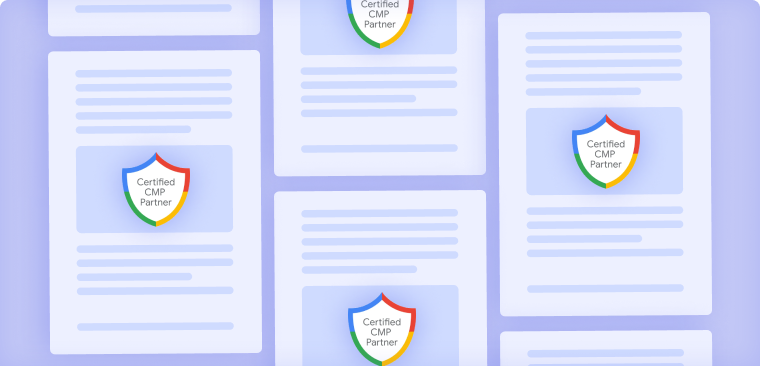Google Consent Mode V2: Preparing Your Marketing for 2024
June 20, 2024
•
4 min read
Table of contents
back
to the top
The digital landscape is always changing, and staying up to date with new regulations and technologies is crucial for any business. One of the key developments marketers need to be aware of in 2024 is Google Consent Mode. This tool helps websites balance effective data-driven marketing strategies with stringent privacy requirements.
Understanding Google Consent Mode
Google Consent Mode helps websites manage user consent for analytics and advertising cookies while complying with global privacy laws like GDPR. It allows your website to adjust how Google services operate based on user consent status, ensuring your marketing efforts remain effective and legally compliant.
Here's how it works: When users consent to cookies, Google tags—such as Google Analytics and Google Ads—function as usual. When users decline consent, these tags adjust their behaviour to respect user preferences, ensuring no personal data is collected without permission. This dual functionality helps websites maintain performance while honouring user privacy choices
Key Features and Benefits
Google Consent Mode dynamically adjusts how Google tags operate based on user consent. This means that even without full consent, tags can still provide anonymized insights, helping you understand user behavior without compromising privacy.
1. Dynamic Tag Behaviour: Google Consent Mode dynamically adjusts how Google tags operate based on user consent. This means that even without full consent, tags can still provide anonymized insights, helping you understand user behavior without compromising privacy.
2. Enhanced Privacy Compliance:By integrating with your website’s Consent Management Platform (CMP), Google Consent Mode ensures that all data collection activities align with user preferences and legal requirements. This significantly reduces the risk of non-compliance with regulations such as GDPR and CCPA.
3. Optimized Conversion Measurement: Even with partial user consent, Google Consent Mode can help you measure conversions more accurately. It uses consent signals to fill in gaps in your data, providing a more comprehensive view of your marketing performance without infringing on user privacy.
4. Improved User Experience: By respecting user consent preferences, Google Consent Mode contributes to a more trustworthy and transparent user experience. This can enhance user trust and loyalty, as visitors feel more secure knowing their privacy choices are respected.
Implementing Google Consent Mode
To appropriately implement Google Consent Mode, follow these steps:
1. Update Your Tagging Setup: Ensure your Google tags are updated to work with Consent Mode. This involves modifying the tag configuration to respect consent signals.
2.Integrate with a CMP: Choose a CMP that supports Google Consent Mode. This integration allows you to manage user consent seamlessly across your website.
3. Configure Consent Signals: Set up consent signals in your CMP to communicate user preferences to Google tags. This ensures that tags adjust their behavior based on the consent status.
4. Test and Monitor: After implementation, thoroughly test your setup to ensure everything works as expected. Monitor the performance and compliance of your tags to maintain an optimal balance between data collection and privacy.
Challenges and Considerations
While Google Consent Mode offers significant benefits, it’s important to be aware of potential challenges, such as:
1. Technical Complexity: Implementing Google Consent Mode requires technical knowledge and may involve significant changes to your existing tagging setup. Ensure you have the necessary expertise or seek professional assistance if needed.
2. User Consent Rates: The effectiveness of Google Consent Mode depends on user consent rates. If a significant number of users decline consent, the amount of data you can collect will be limited. Therefore, it’s crucial to design user-friendly consent requests that encourage opt-ins.
3. Ongoing Compliance: Privacy regulations are constantly evolving, and staying compliant requires ongoing effort. Regularly review and update your consent management practices to ensure they meet the latest legal requirement
Conclusion
Google Consent Mode is an essential tool for any website navigating the complex landscape of data privacy and compliance in 2024. By dynamically adjusting tag behavior based on user consent, it offers a balanced approach to data collection and privacy protection. Implementing Google Consent Mode with a reliable CMP can enhance your marketing effectiveness while ensuring compliance with global privacy laws. Stay ahead of the curve and ensure your business is ready for the changes that 2024 will bring.
Post Scriptum
If you’re interested in GDPR compliance and want to learn more about managing cookie policies and user consent, I recommend exploring our resources at CookiePal. We provide tools and guidance to ensure your website meets all necessary data protection standards. For further discussions and insights, feel free to comment on this post.
Explore further

Cookie Control Explained: What It Is and Why Your Website Needs It
Cookie control: manage cookies and user consent, block trackers until opt-in, log preferences for GDPR compliance, and build user trust with a flexible CMP.
August 29, 2025
3 min

CMP and AI: Can You Use AI While Staying Privacy-Compliant
A concise guide to using AI under GDPR: how consent, transparency, and your CMP ensure LLMs and AI tools stay ethical, compliant, and future-proof.
November 20, 2025
2 min

When Users Say No: What You Can (and Can’t) Do Without Consent
A clear guide to what GDPR blocks when users refuse consent, what’s still allowed, and how CMPs and smart fallbacks help you stay compliant without harming UX or marketing.
November 26, 2025
2 min



